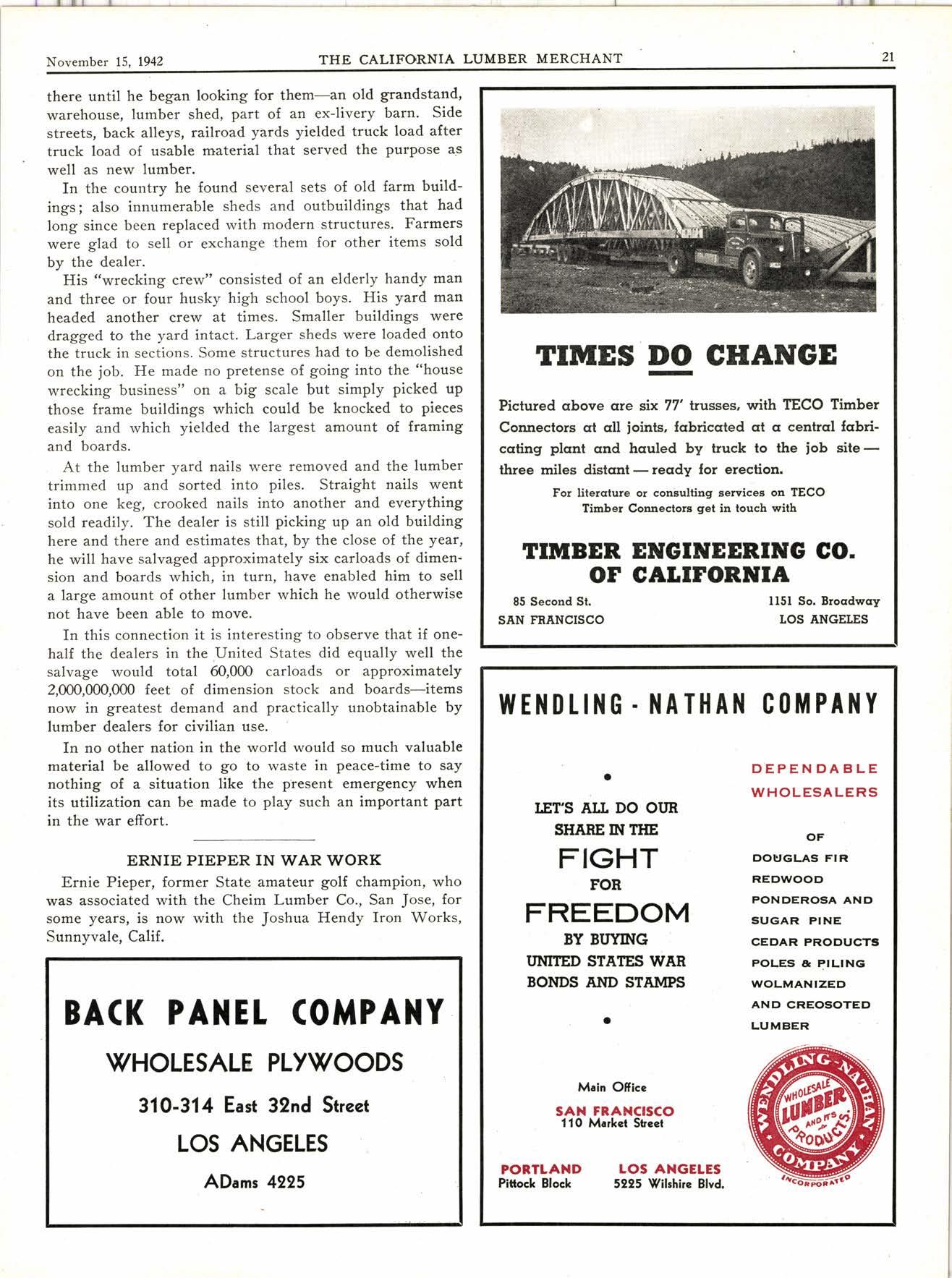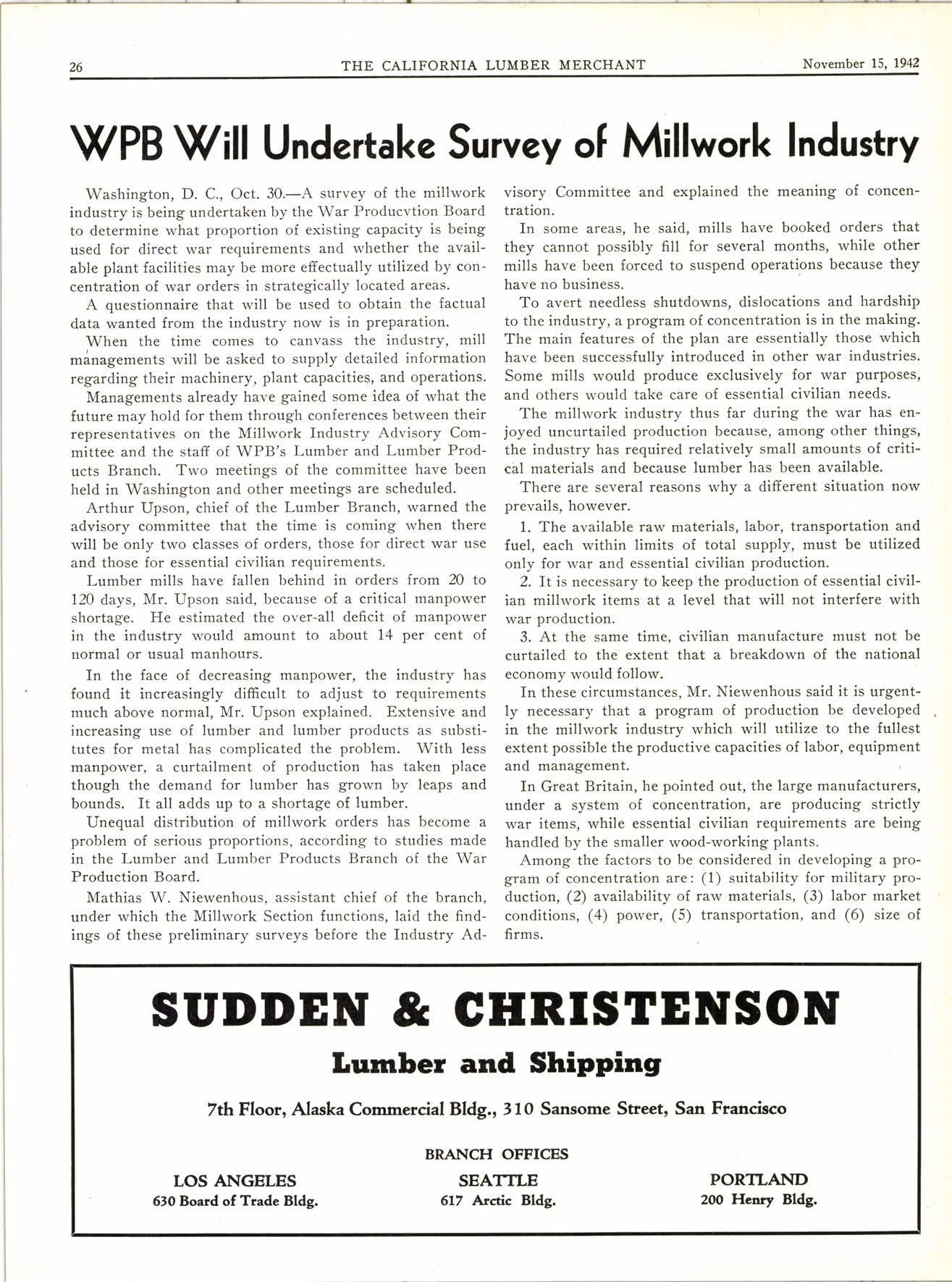
5 minute read
Maximum Price Regufation No. 251
Washington, D. C., Oct. 31.-A new regulation providing specialized price control for the vast American construction industry was issued today by Price Administrator Leon Henderson.
The regulation covers all construction and maintenance services and sales in which contractors, builders, installers and erectors furnish building or iridustrial equipment or materials, together with the labor or services required for actual construction, installation or service.
The pricing provisions of the new regulation are designed to accomplish three things: (1) to maintain the March, 1942, price level (with some exceptions) ; (2) to afford a workable means for determining a maximum price at this level; and (3) to maintain a constant observation over prices of construction not already under the control of other government agencies in order to disclose any activity where existing controls are not adequately preventing inflationary pricing. Since May, the industry in most instances has been strbject to the General Maximum Price Regulation.
Ceilings established by the new regulation are the equivalent of those generally in effect during March, 1942, adjusted for increases in labor costs between March 3I, 1942, and July l, 1942, the date on which the construction industry stabilization agreement between certain government agencieg and the Building Trades Department of the American Federation became effective.
The field covered by the regulation is so broad that it extends from the simple repair of a leak in a roof to the construction of a great project like Boulder Dam. Included are such jobs as the stringing of new telephone or power lines, and the construction of streets and sewers. Ceilings also are established on everyday ordinary household repair and service jobs by plumbers, paperhangers, carpenters and electricians.
The regulation covers construction and repair work when done by the "job," but it does not apply to the wages of persons performing these jobs. Thus, a reroofing contract that named a price for the entire job is covered by this regulation, but if the householder bought the roofing material and employed a roofer to lay it, the pair would not be subject to the regulation.
Representatives of the interested unions, as well as contractors and representatives of the national contractors' associations, along with Government representatives, partici- pated in the conferences which led to the formulation of the regulation. fn order to adjust the pricing mechanism to the nature and practices of the industry and to simplify its administration, maximum pricing formulas have been established for three different types of sales: (1) sales of all type5 not in excess of $50O; (2) sales in excess of $500 on a cost-plus basis; and (3) sales in excess of $500 on lump-sum basis.
The new controls are contained in Maximum Price Regulation No. 25l-Construction and Maintenance Services and Sales of Building and Industrial Equipment and Materials on an Installed or Erected Basis-and becomes efiective November 5,1942.
A short formula has been outlined for the sales below $s00.
This is: To the price which would have been charged for the sale in March, 1942, the seller may add .the increases in labor costs on the job up until July l, 1942. The result is his maximum price.
For contracts of more than $500 on a basis of cost-plus a percentage of cost, or cost-plus a fixed fee, or any other basis in addition to cost, maximum prices are to be computed as follows:
1. Materials and supplies at actual cost.
2. Labor at actual cost, but in amount not to exceed labor costs at rates in the area of installation in effect on July 1,1942.
3. Other direct actual costs, including cost of sub-contracts.
4. Margin for overhead and profit at March (1942) rates, based on a comparable sale, or under certain circumstances, the seller's general experience and that of the industry. In contracts of more than $500 on a lump-sum basis, maximum prices are to be computed as follows:
1. Estimated cost of materials and supplies.
2. Estimated labor costs on the basis of rates in the area of installation in effect on July l,1942.
3. Estimated other direct costs, including sub-contracts.
4. Estimated reserve for contingencies.
5. Estimated margin for overhead and profit at March (1942) rates, listing the method by which this is computed. Every contract entered into, excepting those of $500 or less, after the effective date of the new regulation must be reported to the Office of Price Administration. The agency has designed a system for filing these reports, permitting contractors, where possible, to use copies of their estimating sheets and other ordinary cost formulas. They must be filed within ten days after the award of the contract.
Not less than ten days preceding final settlement, under a lump-sum contract, the contractor is required to file a further report with the Office of Price Administration, setting forth the actual costs of the various items indicated in the original estimates on file.
It is the responsibility of the contractor, in all instances, to have a copy of the new regulation available for examination by his purchasers.
The new regulation excepts from its provisions contracts with the War and Navy Departments under certain circumstances. Contractors engaged in work for the War or Navy Department, or subcontractors on their jobs, are excluded on the condition that the department involved certify that the contract or subcontract has been negotiated, or will be renegotiated, in accordance with a plan previously filed by the agency with the Office of Price Administration.

This was done because the Office of Price Administration investigation prior to issuance of the order showed that War and Navy alpeady were exercising some degree of control over the prices they paid for the performance of construction work. Contractors on such work also will have to file certificates saying they have not purchased any materials at higher than maximum legal prices.
With these exceptions, the new order is designed to regulate all kinds of sales and services common to the construction industry-repairs, improvements, remodeling, and new construction work for residential, commercial, industrial, sanitation, communications, transportation, flood control, power development, reclamation, and other similar projects or services.
Other high points of the order are:
Bonuses: Prohibited except upon specific approval of the Office of Price Administration.
Certificates of Compliance: Mandatory in sales of more than $500; may be demanded by purchaser in sales of less than $500.
Enforcement: The criminal penalties, civil enforcement actions, license suspension proceedings and suits for treble damages provided in the Emergency Price Control Act of
L942 are applicable against violators. There is a sharp prohibition against evasion.
Licensing, Registration: Operators licensed as a condition of doing business as of effective date of order may be required to register.
Records: Must be kept available for the Office of Price Administration examination.
Petitions for Adjustment: May be sought by contractor engaged on Government contract, or sub-contract, who believes the regulation threatens to impede production of any essential war commoditv.
BOB BURNS NOW MAJOR rN ARMY
L. G. "Bob" Burns, head of the Burns Lumber Company and Burns Steamship Company, Beverly Hills, is now in the Transportation Corps of the Army, with the rank of Major. He is stationed at Fort Mason, San Francisco.
Paul Penberthy Flies North
Paul Penberthy of the Penberthy Lumber Company, Los Angeles, left November 11 on a business trip to Portland and Seattle. He is traveling by air and expects to be back at his desk November 19.
CLARK & WILSON CLOSE L. A. OFFICE
Clark & Wilson Lumber Co., manufacturers of Douglas Fir lumber, closed their Los Angeles office at the end of last week.
Chas. P. Henry, well known lumberman, has been manager of this office for the pagt several years.
Now In Navy
L. V. Baskett, Baskett Lumber Company, Whittier, has been commissioned a Lieutenant Commander in the navy, and reported for duty last month. His brother and partner, H. C. Baskett, is in charge of the business.
Gets Deer And Elk Limit
Bill Sampson of the Sampson Company, Pasadena, made sure of at least a part of his winter's meat supply when he got the limit of elk and deer on two recent hunting trips in Utah.










